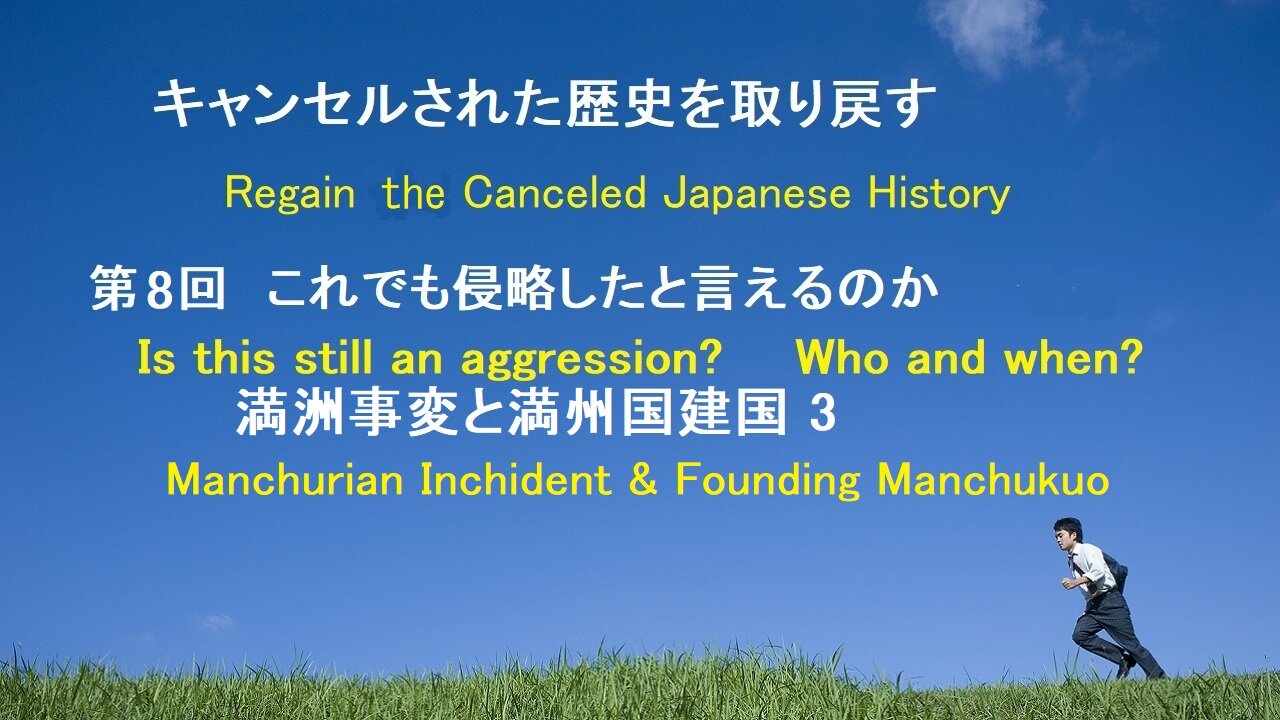Premium Only Content

Manchurian Incident & Founding Manchukuo 3
Hello everyone. 8th Regaining Canceled History. Is this is still an aggression, the Manchurian Incident and the founding of Manchuria 3.
In May 1933 (Showa 8), Japan signed the "Tanggu Ceasefire Agreement" with the Chiang Kai-shek government and decided to settle the Manchurian Incident.
"After the signing of the Tanggu ceasefire agreement, the 800,000-strong Chiang Kai-shek government forces embarked on a campaign to surround and destroy the 150,000-strong Communist army.
The Communist Army abandoned the Soviet districts it had built up and fled to Yan'an.
The Comintern must have been panicked by this.
Manchuria is more than three times as large as Japan. Please take a look at the pictures of how Manchuria developed.
Obviously, the armed forces, government, and police organizations in Manchuria will only function with the cooperation of the people of Manchuria.
The photos I will show you are used with the permission of the administrator from the "Manshu Photo Studio" on the homepage.
Not only the pictures of Manchuria, but the manager is from Manchuria and the explanation is very accurate.
For example, you can see that Japanese immigrants to Manchuria were carried out not only by agricultural immigrants as described in textbooks, but also by a wide range of industries.
We can also see that agricultural migrants often failed. By the time their life stabilizes, you can see the hardships of immigrants, such as being attacked by bandits and losing their young lives to pneumonia.
Naoki Hoshino, who was the Secretary of General Affairs of Manchukuo, wrote about the development of Manchukuo in his book "An Endless Dream: A History of Manchuria Abroad.
Of particular note in the civilian field are the construction of new cities and the remodeling of existing cities.
Under the modern land plan, Japanese construction engineers were gathered and beautiful modern cities were born one after another in the vast land of Manchuria.
In particular, the new national capital, Shinkyo, now Changchun, was constructed as a million cities, equipped with electricity, water and sewage, and the first flush toilet in the Orient, and was colored with abundant greenery.
In addition, Manchuria Railway established Manchuria Railway Hospital, Institute of Medical Science, Japan Anti-Tuberculosis Association, recreation center, etc. in each city along the railway line, and provided patrol treatment in remote areas, greatly contributing to the improvement of the health condition of the people.
In addition, the Central Laboratory and Agricultural Laboratory were established, and the "improved soybeans" developed here became widespread throughout Manchuria and became the driving force for growth as the world's number one soybean exporter.
In addition, the Geological Research Institute, the Railway Technical Research Institute, and the Iron and Steel Research Institute have become the driving force behind the development of agriculture, industry, and mining in Manchuria.
Almost all of the above national land development and industrial development were made by investment from Japan.
For example, the five-year primary industrial development plan compiled in 1936 lists areas for increased production, from electricity, steel, coal and aluminum to airplanes and automobiles.
The total investment was 2.5 billion yen, which exceeded the total expenditure of Japan's general account of 2.4 billion yen in the same year.
Japan invested a huge amount of human resources, technology and capital to bet on the development of Manchuria. Meanwhile, the condition of Manchukuo changed completely.
Security was completely secured and there was no soldier-bandit in the country. From an agricultural country to a fine industrial country, the total production value has doubled. National life has improved remarkably.
Many people gathered from all over the area, and the population, which was 30 million, has exceeded 50 million. I will omit it below.
The born Manchukuo was developed not only by the Japanese who have reached a leading position, but also by the various ethnic groups of Far East.
Young Japanese people have been willing to gather in Manchukuo to share the blessings among all ethnic groups and create a new optimism here. I will omit it below.
With only 13 years of life, the construction of Manchuria has finally ended in an endless dream.
However, the efforts and hardships of the young Japanese people during this time, I am convinced that it is forever enough to be proud of the Japanese people.
As mentioned above, Mr. Naoki Hoshino, the Secretary of General Affairs of Manchukuo, has stated.
As a result, soybean production had increased five times, coal output had increased 14 times, and trade 6 times. What's wrong with this?
Is investment in China good and investment in Manchukuo bad? Then, the Manchurian Incident and the founding of Manchukuo, Part 3 will be completed. See again.
-
 3:10:51
3:10:51
Laura Loomer
4 hours agoEP129: NY Democrats Elect Jihadi Communist
31.2K15 -
 3:01:30
3:01:30
Barry Cunningham
6 hours agoPRESIDENT TRUMP HAS SPARKED A NEW ATTITUDE! DO YOU FEEL IT?
64.4K47 -
 8:05:28
8:05:28
RalliedLIVE
9 hours ago $2.54 earnedSpecialist Addicted Man Plays Warzone
56K2 -
 1:05:42
1:05:42
I_Came_With_Fire_Podcast
7 hours agoFaith & America's Founders
19.7K2 -
 9:21:33
9:21:33
Dr Disrespect
13 hours ago🔴LIVE - DR DISRESPECT - THE BEST IS BACK!
189K24 -
 1:32:53
1:32:53
Badlands Media
21 hours agoAltered State S3 Ep. 34
62.3K4 -
 43:41
43:41
CarlCrusher
4 hours agoSHOCKING Discovery on the Path of the Skinwalker | Thunder Strike Ranch | Episode 2
25.4K3 -
 30:58
30:58
Solar Groove Muzic
1 day ago $0.47 earnedSUMMER AFRO HOUSE BEATS of 2025
19.1K1 -
 8:38
8:38
WhaddoYouMeme
9 hours ago $1.71 earnedChristians in Iran Are Being Hunted—Here’s Why
25.2K22 -
 3:49:16
3:49:16
VapinGamers
6 hours ago $0.73 earnedCOD Black Ops 6 with Abnerdagreat, Gunnin and Runnin! - !rumbot
18.6K1